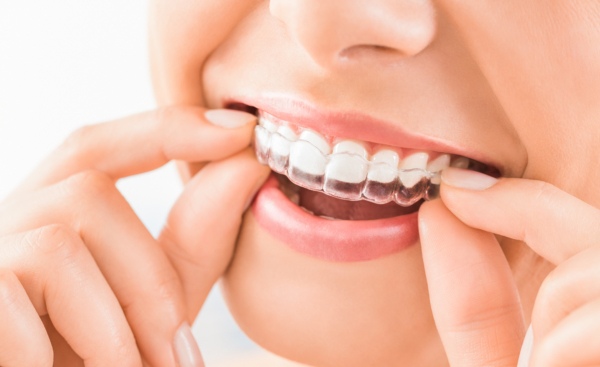The first impression counts
For many people, white, beautifully shaped teeth are an expression of their physical fitness, attractiveness, and self-esteem. Beautiful teeth are one of the beauty ideals of our time. Whether you're looking for love or wanting to make an impression at work: you can only make one good first impression. People who do not take pride in their appearance often do not stand a chance. We are here to help you to fulfil your personal (tooth) dreams. We have developed a 6-step approach to fulfilling these dreams and we use this devise a plan that is personal to each patient and provide them with the perfect treatment.
1
Prophylaxis

Healthy teeth for a lifetime
Nowadays, we can preserve teeth into old age thanks to targeted preventive care. Good oral hygiene and a healthy diet are paramount for counteracting the most important diseases of the oral cavity, such as caries and gum disease. But these are not enough on their own. Stubborn deposits and bacterial coatings (plaque) on hard-to-reach tooth surfaces will need to be cleaned by a hygienist, as part of a professional teeth cleaning procedure, at our dental practice.
2
Bleaching

White teeth and no regrets – bleaching at our practice using Philips Zoom
White teeth look beautiful and help people to laugh without worrying about the appearance of their teeth. Whitening is easy, but it’s also easy to get it wrong. When done incorrectly, whitening can damage dental nerves (pulp) and gums (gingiva). You can damage your enamel when using whitening (often very abrasive) toothpastes or trying to whiten your teeth yourself. That is why we recommend that you only have your teeth whitened by professionals at a dental practice. After all, this is a very good procedure for improving the appearance of your teeth. It’s also important to get an idea of the costs involved in bleaching. Our bleaching expert Grit Berger can look back on more than 10 years of experience in bleaching and has also mastered the latest methods. She also provides advice about the price and the costs involved in her bleaching treatments.
Inside or outside – what causes tooth discolouration?
If your teeth are discoloured on the outside (extrinsic discolouration) they do not need to be bleached, they need to be cleaned by a professional. Extrinsic discolouration is caused by drinking foods and drinks with colourings (e.g. coffee and red wine). If intrinsic discolouration is the cause, your teeth are permeated by discolouring substances from the inside. Different bleaching methods can be used to remove discolouration such as this. If your teeth have already been subjected to an abrasive whitening procedure in the past, then this should be carried out by a professional at our practice. We have a great deal of experience in bleaching and can provide you with services that are particularly sparing. Good to know: bleaching does not “discolour” the tooth. Colour pigments are broken down in the tooth by applying liquids. This makes it easier for oxygen to be deposited. The tooth reflects light better and appears whiter. Finally, a successful bleaching session helps to effectively protect the teeth from any possible temporary sensitivity.
What results can I expect to see?
- Grey-brown discolourations will be reduced.
- You will see an improvement of up to 95% in yellow-brown discolouration.
- The results of bleaching are still visible after three years in two thirds of patients.
- More than one third of patients have reported being able to notice the difference even after seven years.
3
Ceramic inlays

Dental inlay: perfect for your smile
The teeth are one of the most integral parts of our body. Ideally, they should last you your entire life. Our teeth are exposed to an enormous amount of strain: Daily use wears them down, and poor dental hygiene and genetic predispositions do the rest. The dream of having a beaming white smile often does not correspond with reality. Drinking alcohol, caffeine and smoking can lead to unsightly discolouration of the tooth enamel. Yellow teeth and caries are often the result. If caries has crept in and already destroyed the tooth, it is important to act immediately to preserve the tooth’s structure. The hole caused by the caries must be cleaned and hollowed out. The cavity in the tooth is then filled. We tend use what we call inlays when filling cavities like these. An inlay is a special dental filling. A dental technician will make this using the exact measurements for the cavity to be filled. The dental inlay is then fixed directly onto the tooth.
Seven good reasons to have ceramic inlays
1. Durability
Ceramic inlays have an average life of ten to fifteen years. However, ceramic inlays tend to last even longer in the majority of cases.
2. Aesthetic demands
An all-ceramic inlay will meet the highest aesthetic demands thanks to its colour and structure. It is possible to achieve a 1:1 match with the remaining tooth. This is particularly advantageous for front teeth. The translucency of the ceramic gives you a natural looking result.
3. Stability and weight distribution
Ceramic is a very stable material. The ceramic inlay will help to evenly distribute the amount of force that your teeth are subjected to when chewing on a daily basis. You won’t experience any bending or deformation of the material if you have an inlay fitted by a professional. Bonding the inlay to the tooth also serves to stabilise it.
4. Accuracy of fit
Dental inlays can be fitted very accurately by taking an accurate measurement of the cavity to be filled and calculating the dimensions of the inlay. The dental technician will make an inlay that fits the tooth cavity exactly. The advantage of ceramics is that they bond to the tooth, resulting in a very good marginal seal.
5. Using inlays on back teeth
Dental inlays fit perfectly next to adjacent teeth thanks to the specific way in which they have been created. The gap between the teeth, where caries often develops, can be closed. The inlay can completely compensate for pressure differences and tensions at the back of the mouth thanks to the special material properties of ceramic.
6. Health risks
There are currently no health risks associated with the use of ceramic as an inlay material. Allergic reactions can also be ruled out. Experts consider ceramic to be an extremely compatible material.
7. The advantages of having a gold inlay
Ceramic inlays are glued to the remaining tooth. Even very thin tooth walls can be preserved thanks to the stabilising function that ceramic provides. Ceramic corresponds to the tooth in terms of hardness and material properties and will not damage the existing tooth while it is being prepared for the inlay. You can make ceramic inlays look like natural teeth.
4
Veneers

A sparing dental procedure
Veneers are wafer-thin, specifically manufactured ceramic coverings that are permanently bonded to the visible area in front of teeth, and sometimes even behind teeth, which serve to improve the appearance of your smile or of individual teeth. Veneers are one of the gentlest dental procedures and produce amazing results.
Conventional veneers
Conventional veneers make up the majority of the veneers used in Germany, and separate themselves from non-prep veneers in the way in which they are prepared by the dentist. The teeth will need to be prepared slightly before veneers can be fitted.
It is usually necessary to remove part of the tooth or grind down the outer surface by 0.3 – 1 millimetres and this is normally done under local anaesthetic. Please note that the entire surface of the tooth does not need to ground down, only the outer surface.
Non-prep veneers
Non-prep refers to a procedure in which the tooth is not prepared beforehand. Non-prep veneers make aesthetic corrections quick and painless, especially when it comes to improving the appearance of front teeth. You will normally need to attend a brief appointment to take an impression of your teeth. That is why this method is also well suited to anxious patients. As there is no preparation, these veneers can also be fixed to children’s teeth (e.g. following dental trauma or a tooth fracture). Furthermore, they are a suitable solution for patients whose tooth structure is intact but who are unhappy with its appearance.
The advantages of veneers
- The front teeth or the entire row of teeth are visually improved
- Make your whole smile whiter.
- Close unattractive gaps between your front teeth.
- Change the shape of your mouth and the position of your teeth.
- Permanent whitening.
- Lengthening or expanding teeth.
- Outstanding durability.
5
White fillings

Tooth-coloured treatments for issues caused by caries
Plastic fillings (composite fillings) are used to restore colour to front teeth or back teeth affected by caries. They are inserted into “the hole of the tooth” (the cavity) while they are in a plastic state and harden there when they are polymerised (chemically set). They bond with the tooth during this process (dentin bonding technique).
6
Invisalign

The transparent brace
Misaligned teeth are normally corrected at a young age. However, the teeth often shift with age and more and more people are seeking to have their teeth realigned. You can now have your teeth realigned with invisible braces.
Invisalign treatment involves wearing invisible retainers and you will be provided with a new retainer every fortnight. Each retainer is custom-made to fit your teeth. By changing retainers, your teeth are brought closer to the final position your dentist has planned for you, step by step and week by week.
But that’s not all: a virtual 3D treatment plan (ClinCheck®treatment plan) shows you the journey that your teeth will go on as you undergo treatment. Making it possible to see how your teeth will look at the end of your treatment. We use ClinCheck results to create custom-made transparent retainers especially for you.
If you are looking to achieve a smile that improves your appearance, then Invisalign is the right product for you. There is a variety of treatments available, but no other treatment is as comfortable as Invisalign.
Invisalign transforms your smile and does so without disrupting your daily life.




